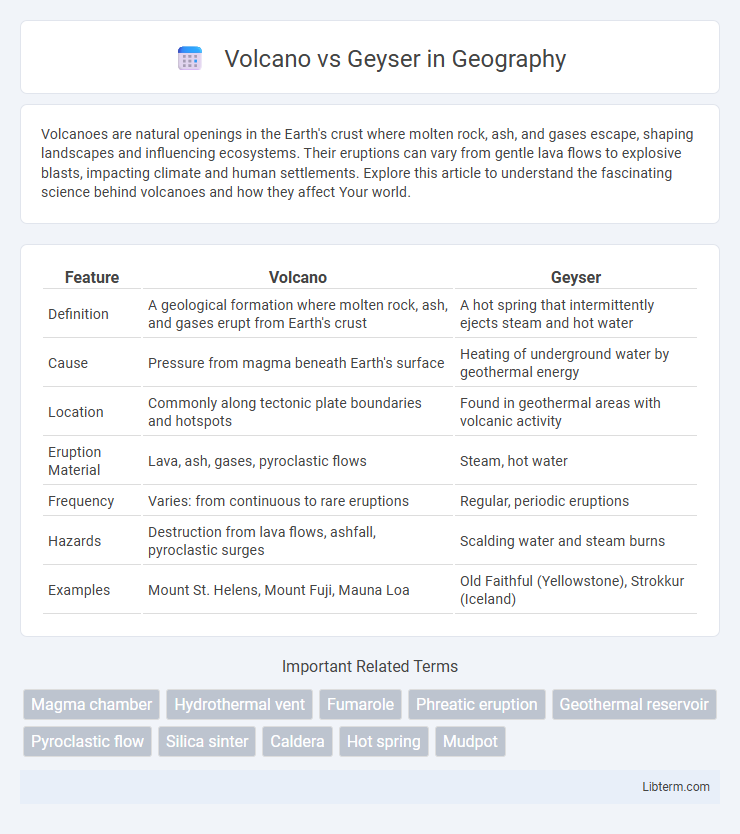Volcanoes are natural openings in the Earth's crust where molten rock, ash, and gases escape, shaping landscapes and influencing ecosystems. Their eruptions can vary from gentle lava flows to explosive blasts, impacting climate and human settlements. Explore this article to understand the fascinating science behind volcanoes and how they affect Your world.
Table of Comparison
| Feature | Volcano | Geyser |
|---|---|---|
| Definition | A geological formation where molten rock, ash, and gases erupt from Earth's crust | A hot spring that intermittently ejects steam and hot water |
| Cause | Pressure from magma beneath Earth's surface | Heating of underground water by geothermal energy |
| Location | Commonly along tectonic plate boundaries and hotspots | Found in geothermal areas with volcanic activity |
| Eruption Material | Lava, ash, gases, pyroclastic flows | Steam, hot water |
| Frequency | Varies: from continuous to rare eruptions | Regular, periodic eruptions |
| Hazards | Destruction from lava flows, ashfall, pyroclastic surges | Scalding water and steam burns |
| Examples | Mount St. Helens, Mount Fuji, Mauna Loa | Old Faithful (Yellowstone), Strokkur (Iceland) |
Introduction to Volcanoes and Geysers
Volcanoes are openings in the Earth's crust where molten rock, ash, and gases erupt, forming mountains or cones through volcanic activity. Geysers are a type of hot spring characterized by intermittent bursts of steam and hot water caused by underground geothermal heat. Both phenomena result from Earth's internal heat but differ in eruption style and geological structure.
Defining Volcanoes: Structure and Function
Volcanoes are geological structures formed by the accumulation of magma, ash, and gases ejected from the Earth's mantle through vents in the crust. Their primary function involves the release of pressure from molten rock, resulting in eruptions that create landforms like volcanic cones, calderas, and lava plateaus. Unlike geysers, which erupt water and steam due to geothermal heating, volcanoes emit molten rock and volcanic gases, shaping Earth's surface over time.
Understanding Geysers: Nature’s Hot Springs
Geysers are rare geothermal phenomena where groundwater is heated by underlying magma until pressure builds, causing periodic eruptions of steam and hot water. Unlike volcanoes that expel molten lava, geysers discharge bursts of boiling water through narrow vents due to subterranean steam pressure. Famous examples such as Old Faithful in Yellowstone National Park showcase these natural hot springs' unique interplay between hydrothermal activity and geological formations.
Geological Origins: How Volcanoes and Geysers Form
Volcanoes form through the movement of tectonic plates and the ascent of magma from the Earth's mantle, creating vents that release molten rock, ash, and gases. Geysers develop in volcanic regions where underground water is heated by magma, causing pressure to build until the water erupts as steam and hot water. Both features reflect geothermal activity but differ fundamentally in their eruptions: molten lava for volcanoes and steam-driven water for geysers.
Key Differences: Volcano vs. Geyser
Volcanoes are geological formations where magma, gas, and ash erupt from the Earth's crust, typically forming mountains, while geysers are hot springs that intermittently discharge water and steam through surface vents. Volcanoes result from tectonic plate movements and magma chamber pressure buildup, whereas geysers depend on underground water heated by geothermal activity that creates steam pressure. The scale and impact differ significantly; volcanic eruptions can alter landscapes and climate, whereas geyser eruptions are localized, often occurring in geyser basins like Yellowstone National Park.
Eruptions Compared: Lava Flows vs. Water Jets
Volcano eruptions primarily involve the explosive release of molten rock, or lava, which flows out and solidifies to form new landforms. In contrast, geyser eruptions eject powerful jets of steam and hot water due to subterranean geothermal pressure, without any lava flow. Lava flows reshape the landscape with hardened rock, while geyser water jets create temporary, high-pressure plumes driven by steam release.
Famous Volcanoes and Iconic Geysers Worldwide
Mount Etna in Italy and Mount Fuji in Japan are among the world's most famous volcanoes, attracting millions of tourists due to their iconic status and volcanic activity. Yellowstone National Park's Old Faithful and Iceland's Strokkur geysers are renowned for their predictable, powerful eruptions of steam and hot water, making them iconic natural features globally. These geological wonders showcase the dynamic processes beneath Earth's surface, drawing scientific interest and offering unique natural spectacles.
Environmental Impact: Volcanoes vs. Geysers
Volcanoes release large quantities of ash, sulfur dioxide, and greenhouse gases such as carbon dioxide, significantly affecting air quality and contributing to climate change. Geysers emit primarily steam and small amounts of dissolved minerals, posing minimal environmental hazards compared to volcanic eruptions. The long-term ecological impact of volcanic activity includes habitat destruction and soil fertility alteration, whereas geysers mainly influence localized thermal ecosystems and water chemistry.
Human Interaction and Tourism
Volcanoes attract millions of tourists annually due to their dramatic landscapes and potential for adventure activities such as hiking and photography, while also posing risks from eruptions that require stringent safety measures. Geysers draw visitors with their predictable eruptions and unique geothermal displays, often located in protected national parks that facilitate controlled access to minimize environmental impact and ensure visitor safety. Both natural phenomena influence local economies through tourism but demand careful management to balance human interaction with preservation of fragile ecosystems.
Conclusion: Volcano or Geyser—Which is More Powerful?
Volcanoes release immense amounts of molten rock, ash, and gases during eruptions, often causing widespread destruction and reshaping landscapes. Geysers eject superheated water and steam, demonstrating impressive bursts but on a much smaller scale compared to volcanic eruptions. While both are powerful natural phenomena driven by geothermal energy, volcanoes exhibit far greater force and long-term geological impact than geysers.
Volcano Infographic

 libterm.com
libterm.com